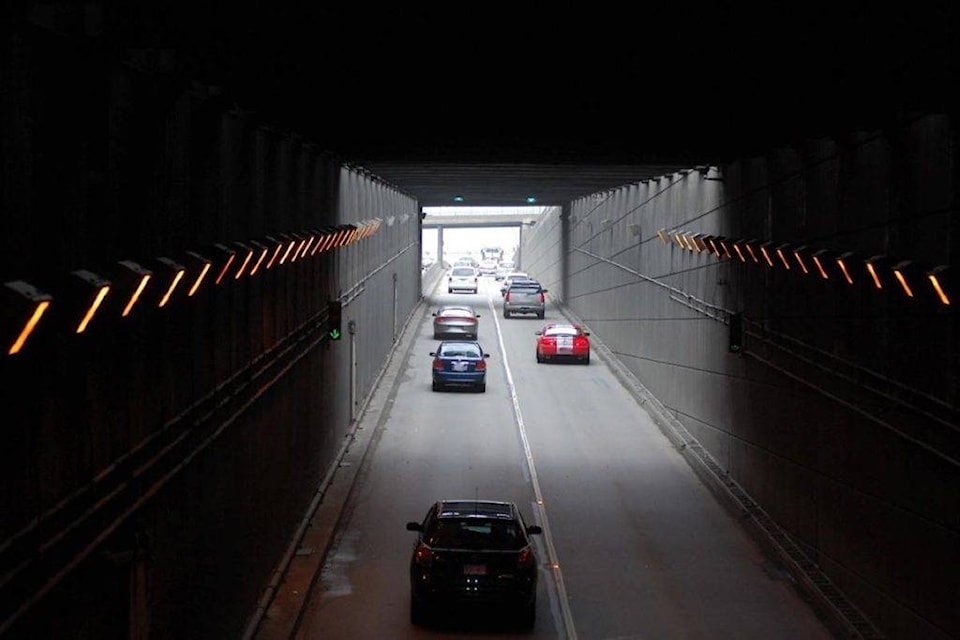The project director for the George Massey crossing has asked for Surrey council’s official input into the project amid what she referred to as a “compressed timeline.”
“We are keenly aware of the importance of this crossing and the urgency of coming to a decision in moving forward,” said Lina Halwani when she appeared as a delegation before Surrey council on April 1.
Halwani asked that the city quickly formalize its input on the current goals and objectives.
“We have a lot do and we want to be sure Surrey has an opportunity to be involved throughout the project,” she told council.
Last December, Transportation Minister Claire Trevena said that a 10-lane bridge to replace the Massey Tunnel was the “wrong project” for communities, and that Delta was no longer fighting to change her mind.
Trevana said the proposal “left out a number of key considerations, like community alignment, livability and cost.”
This came after a long-awaited technical review of the tunnel replacement, which was commissioned after the government halted construction on the 10-lane replacement bridge in 2017. The review outlined three potential options for the Fraser River crossing a six-lane bridge, an eight-lane bridge and a tunnel — but did not recommend one over the others.
RELATED: 10-lane George Massey bridge too big, B.C. study says
On Monday night, Halwani told Surrey council the city will have an opportunity to review and endorse the final draft as the ministry continues work with the Metro Vancouver board as they “develop a solution that better aligns with the regional interest.”
The project’s “goals and objectives” are expected to be finalized this month.
“We hope to achieve informed consensus although we recognize that may not be possible,” said Halwani. “During this phase the public will have an opportunity to comment through our website.”
But public open houses won’t begin until phase two - expected to be finalized in November - which will involve developing and evaluating crossing options, then conducting detailed assessments of shortlisted options.
Phase three, Halwani said, will be the development of a business case by the fall of 2020. Funding partners still need to be identified, she noted.
“Concurrently we’ll work with Richmond, Delta, and Tsawwassen First Nation to identify interim improvement to help relieve traffic congestion,” said Halwani, noting that work is expected to be tender ready by the fall of 2020.
She also reiterated the ministry’s commitment to safety improvement to the tunnel, with that work set to commence this summer.
SEE ALSO: ‘It’s falling apart’: Delta council stresses need for new Massey crossing
RELATED: Unity needed among mayors on Massey Tunnel replacement, Delta mayor says
“Along with Surrey, many communities have clearly told us that something must be done to address the problem of significant congestion at the tunnel,” said Halwani. “From Surrey’s involvement in the previous project and our discussions with staff to date, we understand Surrey wants to work with the ministry to develop a solution and move forward quickly. And that the key interests are building a new crossing with people’s needs in mind including planning for population, employment, growth and related traffic demands. Integration with transit, ride share and cycling are important as people turn to more sustainable modes of travel. Also, rapid transit is a top priority for Surrey and the other South of Fraser communities. We understand your interests in ensuring that we allow for future rapid transit on Highway 99 with good connection to the broad transit network.”
“We also want to assure you that the George Massey crossing has proper connections to existing transportation corridors in Surrey in order to provide the best results for transportation flow in the city,” she added.
Halwani noted the ministry’s goals include improving safety for all road users, improving access and connectivity, and managing congestion.
So far, Halwani said the province has met with 11 municipalities, four First Nation, TransLink and Metro Vancouver staff, as well as the Metro Vancouver board of finance.
“More meetings are scheduled in the coming weeks and we plan to keep making further refinements as these meetings take place. We will share our final findings with the Metro Vancouver finance and intergovernmental committee on April 10.”
After her delegation, there were no questions from Surrey council. Mayor Doug McCallum told Halwani city staff would draft a report to council based on her presentation.
“We’ll make that public when it comes forward to us,” said McCallum.
Meantime, Delta city council has informed the province that a replacement project for the George Massey tunnel has to come sooner rather than later.
In March, at a meeting with Halwani, Delta Mayor George Harvie said completing the crossing by 2025 would be unrealistic if the province and stakeholders settle on an above-ground option that makes contact with the Fraser River. At that point, he said, the process will not only be delayed by a federal environmental assessment, but by opposition by the Tsawwassen and Musqueam First Nations.
If that happens, he said, completion could be pushed to 2030.
“That’s totally unacceptable for us,” said Harvie.
One option Harvie brought up with Halwani was a new deep-bore tunnel which would not touch the river, arguing that it could be a more time efficient solution as well.
Delta Councillor Bruce McDonald did not fully agree with a new tunnel, citing a conversation he had with a guest at last Friday’s economic breakfast who said that if an earthquake strikes, the tunnel may have to be shut down.
Delta Councillor Lois Jackson said she still sees the need for a 10-lane bridge, with each side featuring three car lanes, a transit lane to be used ideally by a SkyTrain system, and an additional lane to handle future vehicle capacity.
-With files from Sasha Lakic and Grace Kennedy
